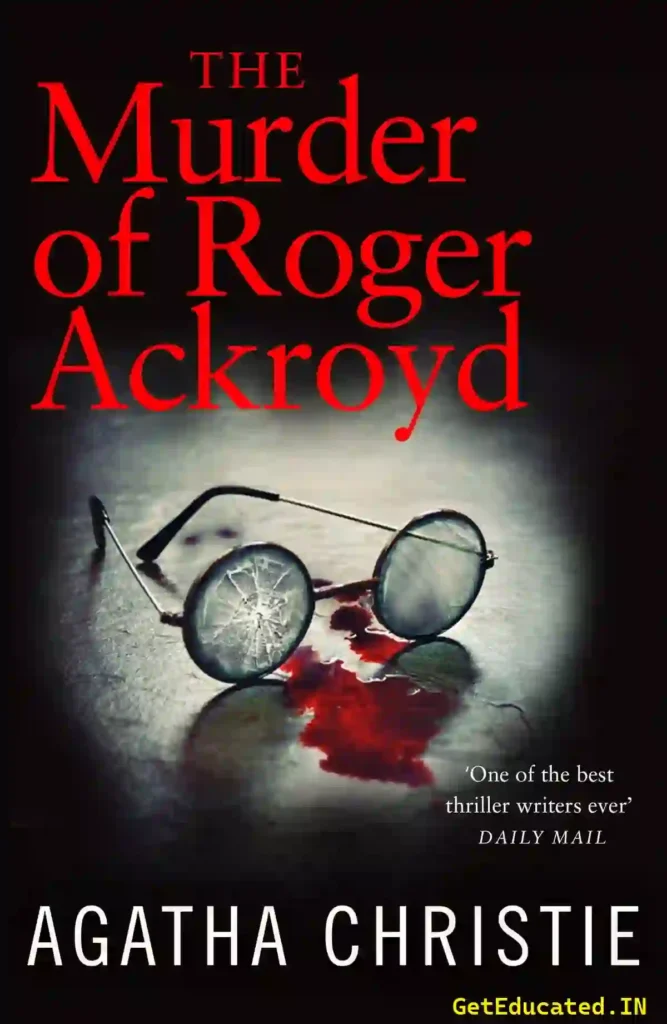
Debatably considered the masterpiece of Agatha Christie, the Murder of Roger Ackroyd, sets the limits for Detective Fiction to a level which was unimaginable in the Golden Age of the Detective novels. Christie enjoys a reputation among critics’ circles as a writer who can easily merge the boundaries of the genre of her writing with unexpected and purely imaginative outcomes. But in the Murder of Roger Ackroyd Christie seems to utilise the (redundant) and limiting conventions of the self same “genre” to fit in with (her) plot, such that in the “inverted “detective novel the conventions and the contradictions go parallel leaving an impact which is as inexpressible as it is gripping.
Detective fiction is a sub-genre of the crime thrillers which gives the reader two gimmicks – a seemingly unsolvable problem and the pursuit to untangle it for which the detective proves instrumental. Yet the heart of the novel is “logical deduction” which beyond all reasons cannot be uncompromised. In the ‘THE MURDER OF ROGER ACKROYD, Agatha Christie follows the major characteristics of a detective novel which are elaborated upon by the work of the clever Hercule Poirot. The Murder of the wealthy and old Mr. Ackroyd takes place in a closed room which could not be accessed without getting in notice of the other members of the house. The event is further complicated when it is revealed that Mr. Ackroyd was heard talking just minutes before he was discovered brutally murdered. The murder provides the perfect exposition for the retired detective Poirot to interfere in the matter and identify the murderer. As critics note the novel is filled with “too many curious incidents which are not related to the crime” and yet perform the role of red herrings which under chaotic sequence of things tangle the story further. With more than 5 suspects and a “missing” prime suspect the novel clearly justifies its position as a detective fiction.
Characteristics of Detective Novel :-
⚫ The criminal must be someone mentioned in the early part of the story, but must not be anyone whose thoughts the reader has been allowed to follow. All supernatural or preternatural agencies are ruled out as a matter of course. Not more than one secret room or passage is allowable. No hitherto undiscovered poisons may be used, nor any appliance which will need a long scientific explanation at the end. No Chinaman must figure in the story. No accident must ever help the detective, nor must he ever have an unaccountable intuition which proves to be right. The detective must not himself commit the crime. The detective must not light on any clues which are not instantly produced for the inspection of the reader.
⚫ The stupid friend of the detective, the Watson, must not conceal any thoughts which pass through his mind; his intelligence must be slightly, but very slightly, below that of the average reader.
⚫ Twin brothers, and doubles generally, must not appear unless we have been duly prepared for them.
Christie’s Roger Ackroyd playfully breaks the very first rule for instance, as well as the ninth rule. The structure of the traditional detective novel is like a jigsaw puzzle. The creation of the puzzle begins with the conclusion, the whole is then divided into parts that exist to be rearranged. In The Murder of Roger Ackroyd, the puzzle begins with the murder, and pieces are slowly arranged and rearranged to retrieve the true picture and reveal the mystery of the death of Roger Ackroyd, the solution of the puzzle. Associated with each piece of the puzzle is suspense and with the progress of the narrative an excitement. The underlying factor is fair play, and the reader must have confidence that eventually all the pieces will fall into place or else he will refuse to play the game. The whole process is a pattern that is invoked in each work of detective fiction.
Patriot clarified all the characters innocence including Charles Kent, Parker and other family members as well as friends of Roger Ackroyd who were involved with the murder of Roger Ackroyd. Throughout the investigation, it is revealed that these characters were only hiding their inner secrets that has no relevance to the murder. It is then revealed that the night when Raymond and Blunt heard Ackroyd talking to someone else was just a misunderstanding. It was a dictaphone that he bought a week before Sheppard had already stabbed him back while he was returning home and put him in his study room locked the room and planted the shoes of Ralph Paton to make him look like a murderer. It was full plan and a plot at the beginning to make others look like a murderer and eliminate the true murderer. Critically, one can see the mindset of a criminal that the criminal tries to remove any evidence that relates to them and tries to provide alibi for himself and brings innocent lives to put into suspicion.
In the make believe world of the detective fictions, crime and evil form the perverse part of reality which is easily spotted and hence severely punishable. Following the same convention, Christie also places the narrative of “THE MURDER OF ROGER ACKROYD in the village of King’s Abbot where modernity has not set foot-“We have a large railway station, small post office, and two rival ‘General stores… Our hobbies and recreations can be summed up in one word, ‘gossip’ (‘THE MURDER OF ROGER ACKROYD, Who’s who in King’s Abbot). But the climax of the novel hints at a more dubious reason for selecting the conventional “English country house “setting As Julian Symons notes -“Criminals of Christie’s novels were not generated out of a culture but individual desires” and therefore it is reasonable to argue that the criminals of Christie’s novels are a product of an anxiety which gripped the urban life after the World War Money and sex were the two major reasons for which Christie’s criminals indulged in the evils like murder and theft. In a constantly shrinking world, these were the two forces which guided the man in England to pursue the evil ways and it is hence that through the corruption of the godly doctor (Dr.Shepperd) in the seemingly original and pure country village, Christie wishes to highlight the degraded moral state of the times- a degradation which has spread from the cities to the country.
The detective in the story acts as the link between the reader and the progression of the investigation/ story. He not only demands the trust of the reader but also assumes the position of a competitive figure in the battle of wits between the reader and the investigating detective. But every detective fiction conventionally had only one detective/ character who was allowed to match the wit of the reader but in the ‘THE MURDER OF ROGER ACKROYD Christie introduces the character of Caroline since the very first chapter as a person who could identify strange events “without stepping out of the house”. She is the first character which establishes that link of competition with the reader until Poirot is introduced and in fact it is Caroline only who helps Poirot identify the real murderer through her gossipy nature. Caroline Shepperd is acknowledged by Christie as the precursor of Miss Marple. So, it is not wrong to conclude that “THE MURDER OF ROGER ACKROYD features not one but two detectives.
The multiplicity of events is also noticed in the number of times that the crime is reconstructed with different characters of the story. Unlike the other detective novels where the crime is reconstructed in the end to clearly identify the culprit, the crime is partially reconstructed with each character through the progression of the novel Yet, unlike the other novels of the genre, the climax of Christie’s ‘THE MURDER OF ROGER ACKROYD lies in the revelation of the narrator as the culprit of the murder. In this final revelation, Christie breaks the trust of the reader and delves into a territory which was unchartered in detective fiction – “the criminal mind” It is in fact the untrustworthy nature of the narrator that lashes the reader into accepting a world of deception.
The Murder of Roger Ackroyd thus provides to the reader just what he needs from the formula of detective fiction – a right blend of invention and convention, a plot full of suspense and the sense of ego enhancement that comes as a part of winning the game. The sleepy English village setting also manages to provide the comfort of insular security that the reader expects to find in a work of detective fiction. It is not surprising that this novel remains one of the most read works of detective fiction to date, nearly ninety years after it was originally published. One other fact that separates The Murder of Roger Ackroyd from the action variety of detective novels is that Pirot is in his late seventies in this particular adventure, as Anne Hart, Poirot’s “biographer,’ notes in The Life and Times of Hercule Poirot.
Thus much of the action and puzzle solving in The Murder of Roger Ackroyd is psychological. Christie manages to successfully distance her novels from the detective novels that rely more on the investigation of clues. Christie, writing during the World War years also manages the retain that element that structures the pristine detective novel – suspense, while separating it from the genre that the action variety of novels metamorphosed into the spy thriller.
The Murder of Roger Ackroyd occupies a very distinct place in the history of detective fiction. By challenging the conventions of detective fiction by placing the criminal as narrator, it paved the way for a more self- conscious detective fiction with metafictional qualities, including stylized postmodernist detective and crime narratives such as Paul Auster’s New York Trilogy (1985-1986), Umberto Eco’s The Name of the Rose (1980), and Orhan Pamuk’s My Name is Red (1998) and Jose Saramago’s The Double (2002).
